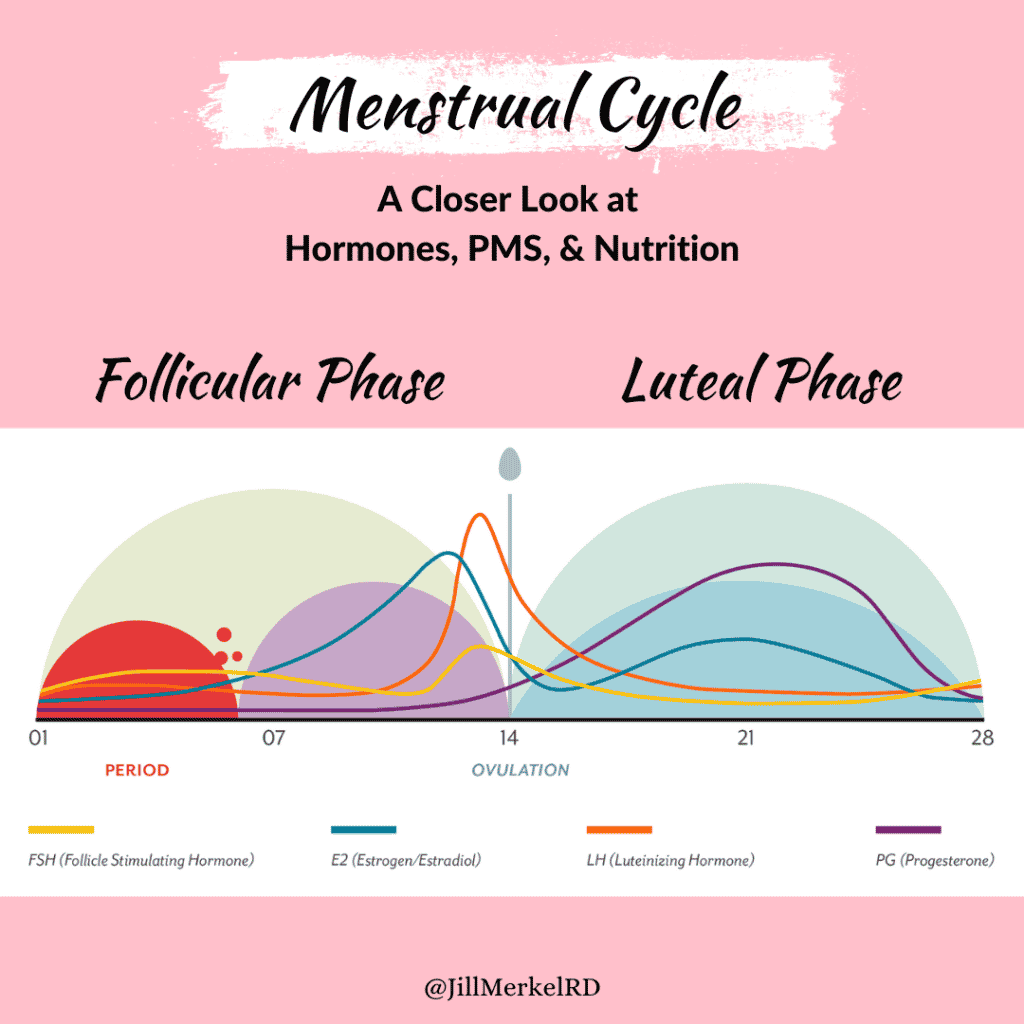The menstrual cycle is a monthly hormonal cycle that prepares a woman for pregnancy. It has various hormones and phases and can become quite confusing to understand! However, let’s break it down to get a better understanding.

Let’s Take a Closer Look at the Menstrual Cycle
The menstrual cycle starts on the first day of your period and ends when your next period begins. Menstrual cycles can range from 24 to 38 days and each cycle may vary in length. The first part of the menstrual cycle, the follicular phase, is when the body is preparing for an egg to be released from the ovaries and when the uterine lining is becoming thicker.
The time range for this phase is from the beginning of menstruation (your period) to the day of ovulation, when an egg is released from the ovary. The second part of the menstrual cycle, the luteal phase, is when the uterus is being prepared for implantation and the body is ready to accept a fertilized egg, if present. If a fertilized egg is not present, the next cycle begins. The luteal phase is between ovulation and before the start of menstruation.
During the follicular phase or pre-ovulation, menstruation occurs. This indicates that the uterine lining is being shed through the vagina. This lasts on average about 5 or 6 days but can go on for 8 days. During menstruation, the pituitary gland releases a hormone called follicle stimulating hormone (FSH), which signals the ovaries to prepare an egg for ovulation. Many egg-containing follicles in the ovaries are stimulated to grow but one dominates in size and is released for ovulation. This large follicle produces estrogen, a hormone, as it grows and its release peaks right before ovulation.
The uterus during the follicular phase is building a thicker inner lining due to the estrogen being released by the follicle. It thickens until ovulation occurs. This lining is where a potential fertilized egg can grow.
After the follicular phase, ovulation occurs. The dominant follicle produces more estrogen and gets larger. As estrogen levels get high, the brain senses this and allows for an increase in luteinizing hormone (LH). Release of LH causes the egg to be released into the fallopian tube which connects to the uterus.

In the ovary during the luteal phase or post-ovulation, the follicle that contained the egg transforms into a corpus luteum which produces progesterone and estrogen. Progesterone peaks about halfway through the luteal phase. The release of these hormones is why women experience menstrual symptoms, such as headaches, back pain, mood changes, bloating, acne, and breast tenderness. The progesterone from the corpus luteum, if the egg is fertilized, supports pregnancy. If the egg is not fertilized, the corpus luteum will break down 9 to 11 days after ovulation. Drops in estrogen and progesterone prepare the body for menstruation.
During the luteal phase, the uterus will either prepare for implantation of a fertilized egg or break down for menstruation. Increases in progesterone cause the lining to stop thickening. The lining also releases chemical messengers to trigger cramping to help trigger a period. If pregnancy is going to occur, chemical messengers will not be sent. If no pregnancy, the corpus luteum stops producing estrogen and progesterone, and this decrease in hormones causes blood vessels to tighten and a period to occur.

The premenstrual symptoms that occur during the luteal phase or about 1 or 2 weeks prior to their period can range in severity from one woman to the next. Some women experience premenstrual syndrome (PMS) which is a mixture of symptoms that are both physical and emotional. Due to the increase of estrogen and progesterone during this time, hormone changes are the culprit. If the symptoms are very severe, a woman might have premenstrual dysphoric disorder (PMDD). In regards to PMS though, PMS goes away after menopause and during pregnancy but comes back after pregnancy.
PMS occurs more often in women with high levels of stress, women with a family history of depression, or women with a personal history of either postpartum depression or depression. Additionally, as a woman ages, hormones are more prone to fluctuations; therefore, PMS can become worse as you age.
Physical symptoms can include:
- Swollen or tender breasts
- Constipation or diarrhea
- Bloating or a gassy feeling
- Cramping
- Headache or backache
- Lower tolerance for noise or light
- Clumsiness
Emotional or mental symptoms include:
- Irritability or hostile behavior
- Feeling tired
- Sleep problems
- Appetite changes or food cravings
- Trouble with concentration or memory
- Tension or anxiety
- Depression, sadness, or crying spells
- Mood swings
- Less interest in sex
A woman most likely has PMS if the symptoms happen in the five days before their period for at least three periods in a row, end within four days after their period starts, and/or keeps her from enjoying or doing normal activities. PMS cannot be diagnosed with a test but talking with a doctor may determine if you have it.
Whether or not if PMS is present, many women experience the typically mentioned symptoms of a menstrual cycle. Due to the estrogen and progesterone increases during the luteal phase, food cravings increase, especially sweet foods, like chocolate, and foods containing carbohydrates and fat. This is natural.
Research has shown that during the luteal phase, food intake increases due to these hormone increases. On the other hand, food intake during the follicular phase seems to decrease. This could possibly explain why weight gain is normal right before a period.

Furthermore, focusing on foods with certain nutrients may help with typical menstrual cycle symptoms before a period.
For example, calcium may help with fatigue, cravings, and depression. Foods with calcium include milk, yogurt, almonds, kale, beans, and fortified foods like soymilk and tofu.
Magnesium may help with cramps, and foods include almonds, pumpkin seeds, chia seeds, spinach, and cashews.
Getting enough iron, 18 mg per day, for women ages 19 to 50 years old help with the iron lost during menstruation. Women with inadequate iron intake can get anemia, which includes symptoms such as fatigue, shortness of breath, and lightheadedness, just to name a few. Food sources of iron include lean meat, seafood, poultry, iron fortified cereals, nuts, and beans.
Along with iron, vitamin C and B vitamins are also important for blood cell production. Vitamin C also helps to absorb plant sources of iron.

If you are concerned your hormones are not working properly, getting them tested may be a good first step. I recommend Modern Fertility if you want to test at home.
Need more support?
I provide nutrition coaching for women’s wellness (body image, chronic dieting, disordered eating, Intuitive Eating).
Free Resource
Do you feel like thoughts about food and your body are all consuming? Download my FREE Guide – 5 Steps to STOP Obsessing About Food and Your Body.

